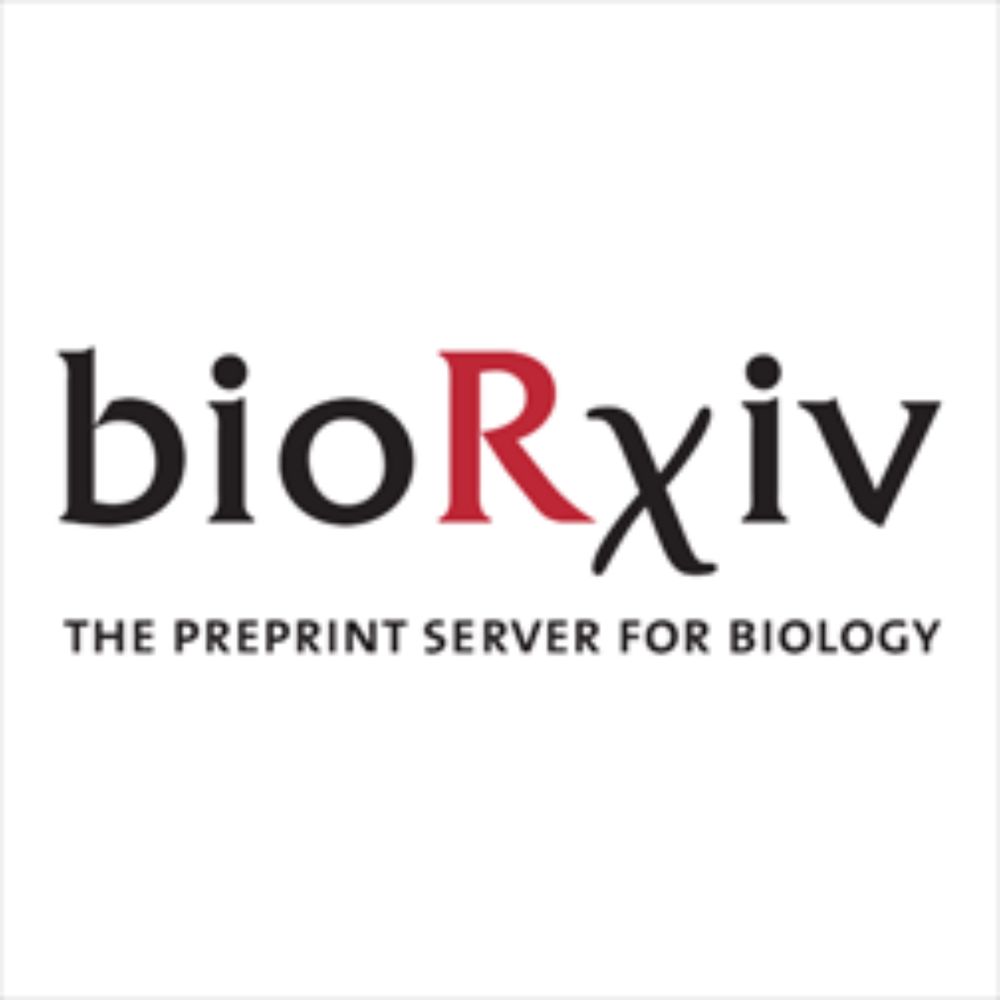
Thrilled to share that our work is now published in Science! ✨
We found a preference for visual objects in the mouse spatial navigation system where they dynamically refine head-direction coding. In short, objects boost our inner compass! 🧭
www.science.org/doi/10.1126/...
🧵1/
11.09.2025 20:12 — 👍 171 🔁 71 💬 8 📌 6

We are excited that our work on inherently interpretable #deeplearning models for #AI for #medicine has been published in @plos.org #digitalhealth! You want to know how to combine the power of deep learning with accessible interpretation? This is for you! ⬇️ journals.plos.org/digitalhealt...
13.05.2025 06:53 — 👍 18 🔁 4 💬 1 📌 0
PhD Position for Deep Learning for Optogenetic Sensory Restoration
How to apply Who to contact? ekfz@sinzlab.org Email subject Start with
🚨 We’re hiring! 🚨
Together with Marcus Jeschke and Emilie Mace we are looking for a PhD student to join us for developing AI tools for optogenetic sensory restauration.
Apply now: sinzlab.org/positions/20...
#PhDposition #AI #Neuroprosthetics #ML #NeuroAI #Hiring
12.05.2025 08:37 — 👍 4 🔁 2 💬 1 📌 0
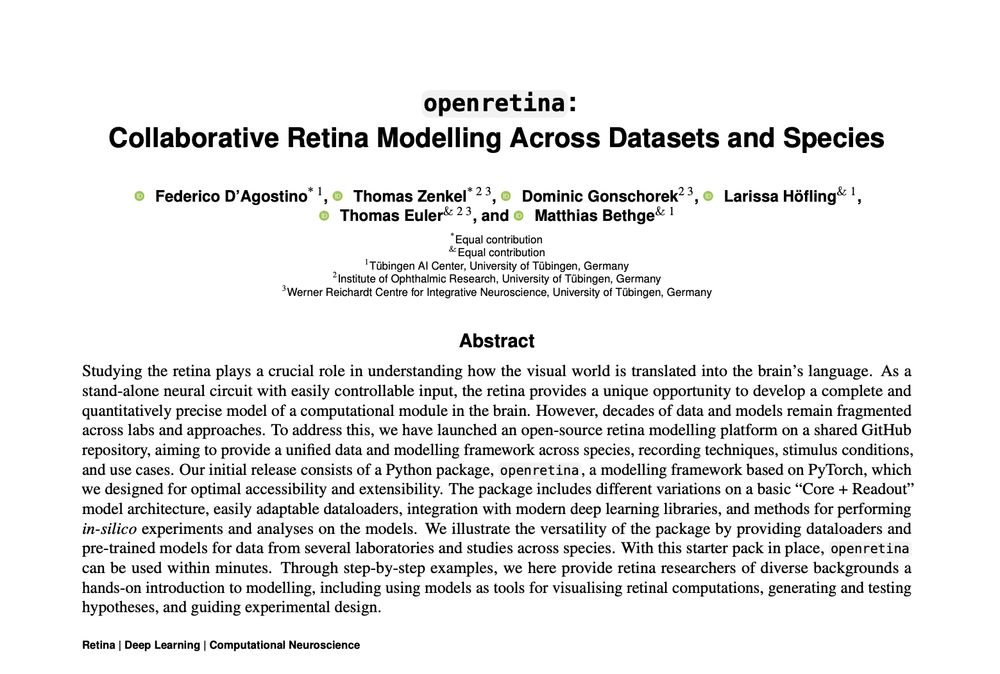
🚨 New paper alert! 🚨
We’ve just launched openretina, an open-source framework for collaborative retina modeling across datasets and species.
A 🧵👇 (1/9)
14.03.2025 09:41 — 👍 38 🔁 20 💬 1 📌 1
Here it is finally: Our mathematical methods book for life scientists! Aimed at advanced undergrads and beginning grad students, plus all those who want a deeper look at the math behind quantitative biology. @portugueslab.bsky.social.
1/3
20.02.2025 18:32 — 👍 131 🔁 39 💬 2 📌 5
Our paper on how the neuromodulator nitric oxide modulates a subset of mouse retinal ganglion cells is finally published in @elife.bsky.social doi.org/10.7554/eLif... Great work by @dgonschorek.bsky.social together with the lab of @oliviermarre.bsky.social and @matigoldin.bsky.social, ...
10.01.2025 15:16 — 👍 26 🔁 12 💬 1 📌 0
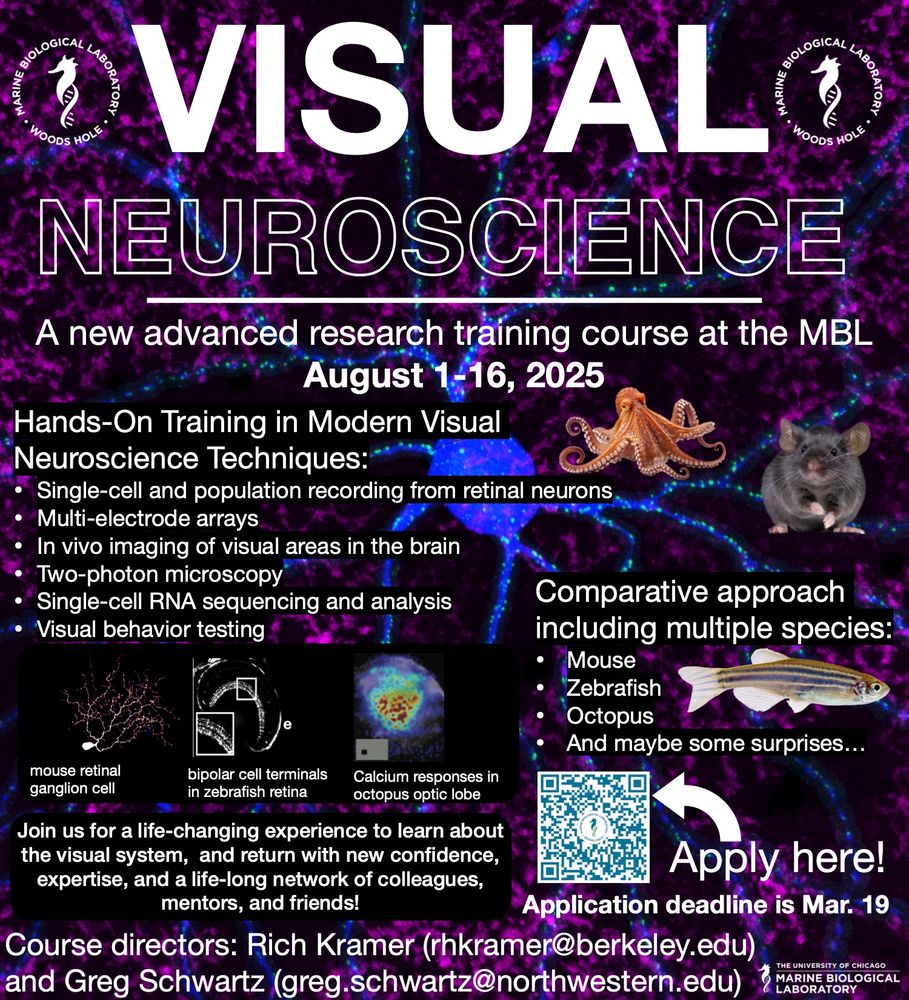
Flyer for a visual neuroscience course with colorful images of scientific data and model species.
I am thrilled to announce that Rich Kramer and I are co-directing a BRAND NEW hands-on visual neuroscience course at the MBL. August 1-16, 2025. Details in this flyer. Trainees please apply. And everyone, please spread the word!
13.12.2024 22:12 — 👍 71 🔁 43 💬 4 📌 2

We have a new PhD position available; please spread the word and repost.
The project will combine retina recordings, computational modeling, and optogenetics to help further develop vision restoration therapy.
See here for more information:
retina.uni-goettingen.de/join-the-lab/
10.12.2024 14:19 — 👍 7 🔁 7 💬 0 📌 0
Early vision Neuroscience community, Vol 1
We are talking eyes, retinas, and some of the more ancestral bits of visual brains. No species restrictions. List is close to full, will start building Vol 2 before too long
Addition requests, please see link in the below thread
go.bsky.app/BotZr1g
29.11.2024 08:16 — 👍 42 🔁 20 💬 4 📌 0
Thanks; good question! I would imagine that looking into coding principles that take more of the cell-type-specific computational properties or (potential) functional tasks into account should be interesting. Without excluding other possibilities.
28.11.2024 14:52 — 👍 1 🔁 0 💬 0 📌 0
Thanks so much to Dimos Karamanlis @dimokaramanlis.qoto.org.ap.brid.gy for spearheading this, and thanks for a great team effort to get the primate retina recordings established and carried out!
27.11.2024 09:42 — 👍 3 🔁 0 💬 1 📌 0

Schematic grating stimulus and subunit-model components for a sample cell.
Subunit models (here with a new modeling framework, applying flickering gratings for parameter fitting) can capture much of the spatial-contrast sensitivity and response correlations. 7/
27.11.2024 09:42 — 👍 4 🔁 1 💬 1 📌 0

Correlations of ON versus OFF parasol and ON versus OFF midget cells.
The nonlinear, spatial-contrast-sensitive mechanisms are even strong enough to induce positive activity correlations between ON and OFF parasol cells in marmosets, but not midget cells (and ON and OFF transient alpha cells, but not sustained alpha cells in mice). 6/
27.11.2024 09:40 — 👍 2 🔁 0 💬 1 📌 0

Plots of partial correlations for linear and nonlinear fixations for ON and OFF parasol cells.
Correlated activity is seen particularly during fixations with high-contrast spatial structure; spatial nonlinearities of receptive fields are largely responsible for triggering the correlated activity. 5/
27.11.2024 09:38 — 👍 2 🔁 0 💬 1 📌 0

Plots of redundancy versus retinal distance for ON parasol and transient OFF-alpha cells.
The correlated activity leads to redundancy in stimulus encoding, e.g., for parasol cells in marmosets or transient Off-alpha cells in mice, challenging the efficient coding hypothesis. 4/
27.11.2024 09:35 — 👍 3 🔁 0 💬 1 📌 0

For some ganglion cell types (e.g., OFF midgets in marmoset retina), activity of cell pairs is strongly decorrelated compared to stimulus correlations (as predicted by efficient coding); other types display hardly any decorrelation at all (e.g., ON parasols). 3/
27.11.2024 09:33 — 👍 2 🔁 0 💬 1 📌 0
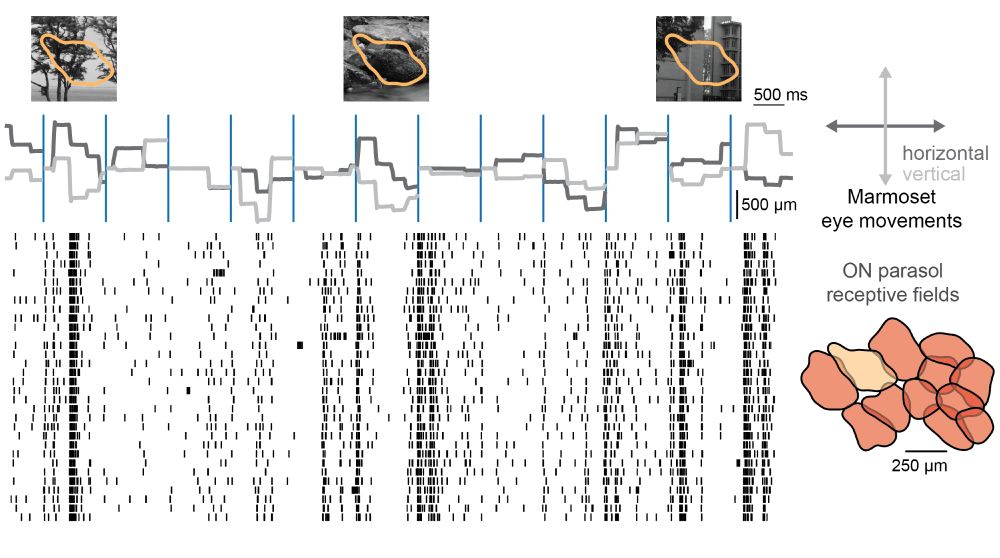
Sample gaze trace from a marmoset and raster plot of spiking responses from a recorded ON parasol cell.
We recorded spiking responses from populations of retinal ganglion cells in marmoset and mouse retina in response to photographs shifted according to species-specific gaze trajectories. We identified ganglion cell types, and assessed their activity correlations and coding redundancy. 2/
27.11.2024 09:32 — 👍 3 🔁 0 💬 1 📌 0
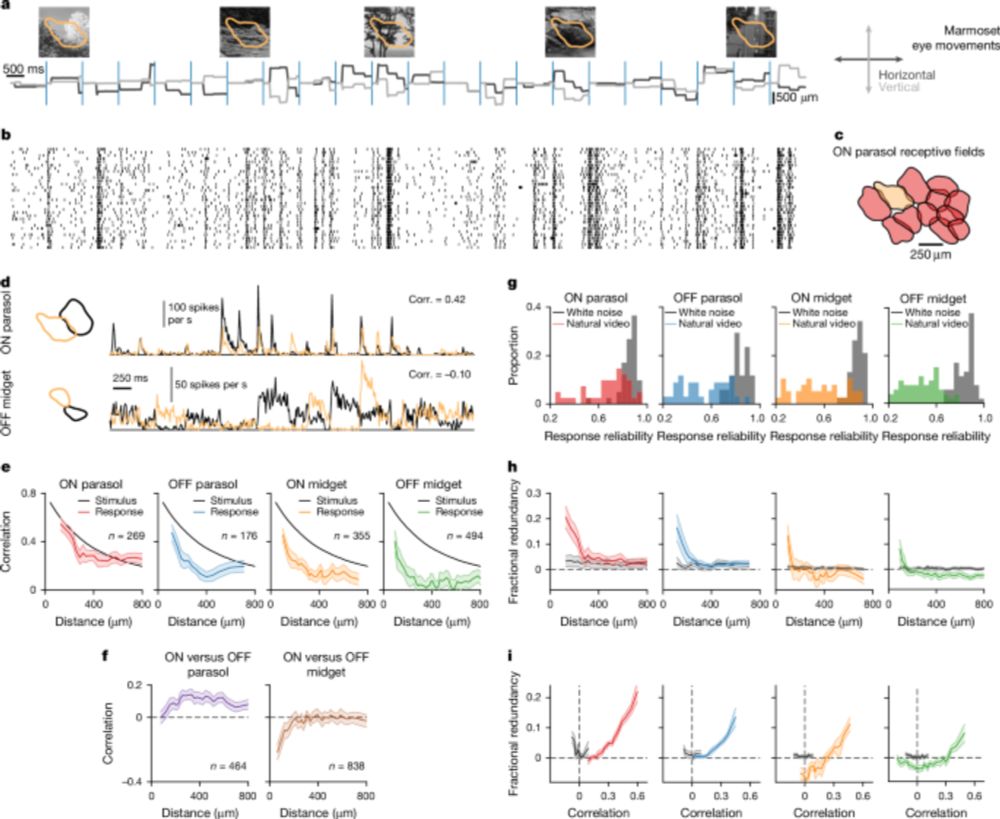
Nonlinear receptive fields evoke redundant retinal coding of natural scenes - Nature
Species-specific gaze shifts with natural stimuli drive correlated spiking in retinal ganglion cells.
How natural stimuli lead to highly correlated ganglion cell activity in primate (marmoset) and mouse retina. Now out in @natureportfolio.bsky.social. And, I guess, great opportunity for a first post on this site. #FirstSkeet Very brief summary in this thread. 1/
www.nature.com/articles/s41...
27.11.2024 09:26 — 👍 49 🔁 14 💬 2 📌 0
Neuroscientist at European Neuroscience Institute Göttingen. Group leader researching the neuronal circuitry underlying memory and action. Alumnus Jacobs University, Oxford, DZNE, LIN, OvGU. http://barnstedtlab.com
ORCID: 0000-0001-7924-6043
PhD Student@University of Sussex w/ Tom Baden
MSc Neuroscience@University of Tübingen w/ Thomas Euler
Interested in visual neuroscience, neural design, evolution.
Neuroscience & functional ultrasound imaging. Vision and brain states. Professor at University Medical Center Göttingen. https://brainwidenetworks.uni-goettingen.de/ Co-Spokesperson, EKFZ Center for Optogenetic Therapies. https://ekfz.uni-goettingen.de/en/
Neuroscientist at the Humboldt University of Berlin, violinist and chamber music enthusiast
Research group at UMD combining data-driven models and machine learning with theories of neural and systems-level computation
Neuroscientist studying thalamic circuits for vision
at University of Göttingen. We study behavior and cognition of humans and primates; funded by Deutsche Forschungsgemeinschaft DFG;
Web: http://www.sfb1528.uni-goettingen.de
YouTube: http://tinyurl.com/36dkn7uu
Impressum: https://www.uni-goettingen.de/de/
Neuroscientist @crick.ac.uk asking how information is processed in the brain.
Odours. Circuits. Neurotechnology. Synchrotrons. BCIs.
Co-founder Paradromics
Twitter: @AndreasTSchafer
Across many scientific disciplines, researchers in the Bernstein Network connect experimental approaches with theoretical models to explore brain function.
Interested in the building blocks of intelligence: neural & computational mechanisms underlying how we rapidly learn, generalize; how our mental models help us experience & infer; curiosity and ideation
https://tarananigam.github.io/TaranaNigam/index.html
Research Group leader @Max Planck Institute of Psychiatry
Systems Neuroscience
State-dependent visual processing
Computational neuroscience and connectomics
Biologist, neuroscientist, interested in memory and what the brain makes of the world. Also, a mum, but less of that here.
just trying to say true and-or kind things
Theoretical physicist and neuroscientist
https://www.silveira-lab.com
https://x.com/Rava_daSilveira
The Laboratory of Computational Neuroscience @EPFL studies models of neurons, networks of neurons, synaptic plasticity, and learning in the brain.
🔬🧫🧪 Experimental biophysicists, studying mechanics of cells using microscopy, x-rays, optical tweezers, AFM; interested in interdiscsiplinary collaborations.
Sir Henry Dale Fellow @ University of Manchester. Vision, light and clocks! 👁️💡⏰







